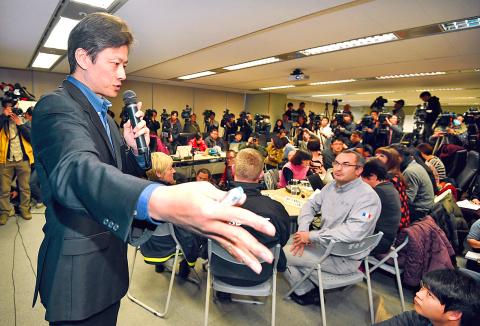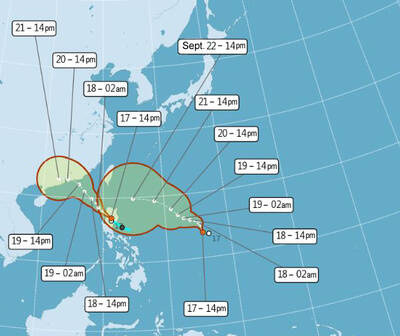The Aviation Safety Council yesterday revealed preliminary information from the flight data recorder (FDR) and cockpit voice recorder of the crashed TransAsia Airways Flight GE235, showing that the pilots may have mistakenly turned off the engine that could have kept it airborne.
Council executive director Thomas Wang (王興中) said that the master warning for the No. 2 engine was triggered about 37 seconds after takeoff, which indicated that the engine had flamed out. During that time, the airplane was flying at an altitude of 457m, he said.
Wang also said that the propellers of the No. 2 engine went into the feathered mode after the flame-out signal. The auto-feather system is activated when the power of the engine becomes insufficient to produce the thrust, he said, adding that the system helps reduce drag during an engine failure.

Photo: EPA
“Even though the flame-out alarm went off, the engine did not actually flame out and was still running,” Wang said, adding that the aircraft’s dashboard should have informed the pilot that it was the No. 2 engine that had malfunctioned.
Despite the problem with the No. 2 engine, Wang said that the flight crew did not shut it down, but decided to increase its throttle.
Wang said that although there was no sign of abnormality with the No. 1 engine, the flight crew manually turned it off when the airplane climbed to 488m, leading that engine to go into feathered mode as well.

Photo: Liao Chen-hui, Taipei Times
The flight crew later tried to restart the No. 1 engine, but did not have enough time to power the engine back into full operation, Wang said.
The data further showed that the aircraft had sounded a stall warning five times before the FDR stopped recording.
After the third stall warning, the flight crew contacted the control tower and called out: “Mayday, Mayday, engine flame-out.”
The council also showed the data plot from the FDR of the engines, which indicated that both engines had operated normally before the No. 2 engine went into feathered mode.
As to what led to the failure of the No. 2 engine and why the flight crew decided to turn off the No. 1 engine following a brief discussion, Wang said that these questions could only be answered after further investigation.
Previously, media reports had speculated that the problem could be with the No. 1 engine, as the company had replaced it twice since it acquired the aircraft from the French manufacturer.
Yann Torres, a representative from the French Bureau of Enquiry and Analysis for Civil Aviation, also attended the press conference and confirmed that the ATR 72-600 airplanes are able to operate with one engine, even during take-off.
Meanwhile, the Civil Aeronautics Administration (CAA) said that all pilots operating ATR 72 models are to be retrained.
Clark Lin (林俊良), director of the administration’s flight standards division, said that the airline has 71 pilots trained to fly ATR 72 planes, adding that they would be required to take an oral test on operating the aircraft.
The test would be administered over four days, beginning today, he said.
Lin said that pilots could still fly the airplanes before they take the test, because they are qualified pilots.
However, they must finish the test within four days and would be asked to be requalified as pilots if they fail the test, Lin said.
The pilots would later be asked to operate a flight simulator as well.
CAA statistics showed that of five TransAsia Airways incidents between 2010 and last year that involved problems with an engine, two of them were attributed to human error.

Taiwan is projected to lose a working-age population of about 6.67 million people in two waves of retirement in the coming years, as the nation confronts accelerating demographic decline and a shortage of younger workers to take their place, the Ministry of the Interior said. Taiwan experienced its largest baby boom between 1958 and 1966, when the population grew by 3.78 million, followed by a second surge of 2.89 million between 1976 and 1982, ministry data showed. In 2023, the first of those baby boom generations — those born in the late 1950s and early 1960s — began to enter retirement, triggering

One of two tropical depressions that formed off Taiwan yesterday morning could turn into a moderate typhoon by the weekend, the Central Weather Administration (CWA) said yesterday. Tropical Depression No. 21 formed at 8am about 1,850km off the southeast coast, CWA forecaster Lee Meng-hsuan (李孟軒) said. The weather system is expected to move northwest as it builds momentum, possibly intensifying this weekend into a typhoon, which would be called Mitag, Lee said. The radius of the storm is expected to reach almost 200km, she said. It is forecast to approach the southeast of Taiwan on Monday next week and pass through the Bashi Channel

NO CHANGE: The TRA makes clear that the US does not consider the status of Taiwan to have been determined by WWII-era documents, a former AIT deputy director said The American Institute in Taiwan’s (AIT) comments that World War-II era documents do not determine Taiwan’s political status accurately conveyed the US’ stance, the US Department of State said. An AIT spokesperson on Saturday said that a Chinese official mischaracterized World War II-era documents as stating that Taiwan was ceded to the China. The remarks from the US’ de facto embassy in Taiwan drew criticism from the Ma Ying-jeou Foundation, whose director said the comments put Taiwan in danger. The Chinese-language United Daily News yesterday reported that a US State Department spokesperson confirmed the AIT’s position. They added that the US would continue to

The number of Chinese spouses applying for dependent residency as well as long-term residency in Taiwan has decreased, the Mainland Affairs Council said yesterday, adding that the reduction of Chinese spouses staying or living in Taiwan is only one facet reflecting the general decrease in the number of people willing to get married in Taiwan. The number of Chinese spouses applying for dependent residency last year was 7,123, down by 2,931, or 29.15 percent, from the previous year. The same census showed that the number of Chinese spouses applying for long-term residency and receiving approval last year stood at 2,973, down 1,520,